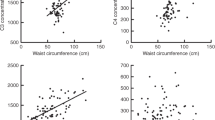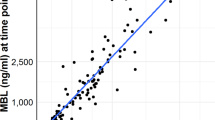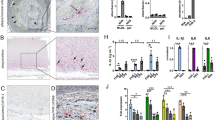Abstract
Hypertension has been associated with raised plasma levels of complement factor 3 and 4 (C3 and C4). The nature of this association is unclear. This population-based longitudinal study explored whether C3 or C4 is associated with development of hypertension. Blood pressure and plasma levels of C3 and C4 were determined in 2178 healthy men, aged 35–50 years, initially without treatment for hypertension. Incidence of hypertension and blood pressure increase over 15.7 (±2.2) years follow-up was studied in relation to C3 and C4 at baseline. Among men with initially normal blood pressure (<160/95 mm Hg), incidence of hypertension (⩾160/95 mm Hg or treatment) was 32, 42, 37 and 47%, respectively, for men with C3 in the first, second, third and fourth quartile (trend: P=0.001). This relationship remained significant after adjustment for confounding factors. Among men without blood pressure treatment, systolic BP increase (mean+standard error, adjusted for age, initial blood pressure and follow-up time) was 17.5+0.8, 19.6+0.9, 19.8+0.8 and 20.8+0.8 mm Hg, respectively, in the C3 quartiles (trend: P=0.004). C3 was not associated diastolic blood pressure at follow-up. Although C4 was associated with blood pressure at the baseline examination, there was no relationship between C4 and development of hypertension or future blood pressure increase. It is concluded that C3 in plasma is associated with future blood pressure increase and development of hypertension.
This is a preview of subscription content, access via your institution
Access options
Subscribe to this journal
Receive 12 digital issues and online access to articles
$119.00 per year
only $9.92 per issue
Buy this article
- Purchase on Springer Link
- Instant access to full article PDF
Prices may be subject to local taxes which are calculated during checkout
Similar content being viewed by others
References
Dannenberg AL, Garrison RJ, Kannel WB . Incidence of hypertension in the Framingham Study. Am J Public Health 1988; 78: 676–679.
Sesso HD, Buring JE, Rifai N, Blake GJ, Gaziano JM, Ridker PM . C-reactive protein and the risk of developing hypertension. JAMA 2003; 290: 2945–2951.
Folsom AR, Peacock JM, Nieto FJ, Rosamond WD, Eigenbrodt ML, Davis CE et al. Plasma fibrinogen and incident hypertension in the Atherosclerosis Risk in Communities (ARIC) Study. J Hypertens 1998; 16: 1579–1583.
Engström G, Janzon L, Berglund G, Lind P, Stavenow L, Hedblad B et al. Blood pressure increase and incidence of hypertension in relation to inflammation-sensitive plasma proteins. Arterioscler Thromb Vasc Biol 2002; 22: 2054–2058.
Gillum RF, Mussolino ME . White blood cell count and hypertension incidence. The NHANES I Epidemiologic Follow-up Study. J Clin Epidemiol 1994; 47: 911–919.
Ritchie RF, Palomaki GE, Neveux LM, Navolotskaia O, Ledue TB, Craig WY . Reference distributions for complement proteins C3 and C4: a practical, simple and clinically relevant approach in a large cohort. J Clin Lab Anal 2004; 18: 1–8.
Moshage H . Cytokines and the hepatic acute phase response. J Pathol 1997; 181: 257–266.
Walport MJ . Complement. First of two parts. N Engl J Med 2001; 355: 1058–1066.
Hoie EB, McGuire TR, Leuschen PM, Zach TL . Pentoxifylline inhibits tumor necrosis factor-alpha induced synthesis of complement component C3 in human endothelial cells. Biol Pharm Bull 2004; 27: 1670–1673.
Oksjoki R, Kovanen PT, Pentikainen MO . Role of complement activation in atherosclerosis. Curr Opin Lipidol 2003; 14: 477–482.
Niculescu F, Rus H . role of complement activation in atherosclerosis. Immunol Res 2004; 30: 73–80.
Torzewski J, Torzewski M, Bowyer DE, Frohlich M, Koenig W, Waltenberger J et al. C-reactive protein frequently colocalizes with the terminal complement complex in the intima of early atherosclerotic lesions of human coronary arteries. Arterioscler Thromb Vasc Biol 1998; 18: 1386–1392.
Yasojima K, Schwab C, McGeer EG, McGeer PL . Complement components, but not complement inhibitors, are upregulated in atherosclerotic plaques. Arterioscler Thromb Vasc Biol 2001; 21: 1214–1219.
Buono C, Come CE, Witztum JL, Maguire GF, Connelly PW, Carroll M et al. Influence of C3 deficiency on atherosclerosis. Circulation 2002; 105: 3025–3031.
Muscari A, Bozzoli C, Puddu GM, Sangiorgi Z, Dormi A, Rovinetti C et al. Association of serum C3 levels with the risk of myocardial infarction. Am J Med 1995; 98: 357–364.
Weyer C, Tataranni PA, Pratley RE . Insulin action and insulinemia are closely related to the fasting complement C3, but not acylation stimulating protein concentration. Diabetes Care 2000; 23: 779–785.
Gabrielsson BG, Johansson JM, Lönn M, Jernas M, Olbers T, Peltonen M et al. High expression of complement components in omental adipose tissue in obese men. Obes Res 2003; 11: 699–708.
Onat A, Uzunlar B, Hergenc G, Yazici M, Sari I, Uyarel H et al. Cross-sectional study of complement C3 as a coronary risk factor among men and women. Clin Sci (London) 2005; 108: 129–135.
Engström G, Hedblad B, Eriksson KF, Janzon L, Lindgärde F . Complement C3 is a risk factor for the development of diabetes. A population-based cohort study. Diabetes 2005; 54: 570–575.
Muscari A, Massarelli G, Bastagli L, Poggiopollini G, Tomassetti V, Drago G et al. Relationship of serum C3 to fasting insulin, risk factors and previous ischaemic events in middle-aged men. Eur Heart J 2000; 21: 1081–1090.
Lefkos N, Boura P, Boudonas G, Zacharioudaki E, Efthimiadis A, Tsougas M et al. Immunopathogenic mechanisms in hypertension. Am J Hypertens 1995; 8: 1141–1145.
Schaadt O, Sorensen H, Krogsgaard AR . Association between the C3F-gene and essential hypertension. Clin Sci 1981; 61 (Suppl 7): 363s–365s.
Lin ZH, Fukuda N, Jin XQ, Yao EH, Ueno T, Endo M et al. Complement 3 is involved in the synthetic phenotype and exaggerated growth of vascular smooth muscle cells from spontaneously hypertensive rats. Hypertension 2004; 44: 42–47.
Berglund G, Eriksson KF, Israelsson B, Kjellström T, Lindgärde F, Mattiasson I et al. Cardiovascular risk groups and mortality in an urban Swedish male population: the Malmö Preventive Project. J Intern Med 1996; 239: 489–497.
Engström G, Lind P, Hedblad B, Stavenow L, Janzon L, Lindgärde F . Effects of cholesterol and inflammation-sensitive plasma proteins on incidence of myocardial infarction and stroke in men. Circulation 2002; 105: 2632–2637.
Wallström P, Wirfält E, Lahmann PH, Gullberg B, Janzon L, Berglund G . Serum concentrations of beta-carotene and alpha-tocopherol are associated with diet, smoking, and general and central adiposity. Am J Clin Nutr 2001; 73: 777–785.
Laurell CB . Electroimmuno assay. Scand J Clin Lab Invest Suppl 1972; 124: 21–37.
WHO. 1986 guidelines for the treatment of mild hypertension: memorandum from a WHO/ISH meeting. J Hypertens 1986; 4: 383–386.
WHO. 1999 WHO-international society of hypertension guidelines for the management of hypertension. J Hypertens 1999; 17: 151–183.
Selzer F, Sutton-Tyrrell K, Fitzgerald S, Tracy R, Kuller L, Manzi S . Vascular stiffness in women with systemic lupus erythematosus. Hypertension 2001; 37: 1075–1082.
Cianflone K, Xia Z, Chen LY . Critical review of acylation-stimulating protein physiology in humans and rodents. Biochim Biophys Acta 2003; 1609: 127–143.
Muscari A, Sbano D, Bastagli L, Poggiopollini G, Tomassetti V, Forti P et al. Effects of weight loss and risk factor treatment in subjects with elevated serum C3, an inflammatory predictor of myocardial infarction. Int J Cardiol 2005; 100: 217–223.
Engström G, Hedblad B, Janzon L, Lindgärde F . Weight gain in relation to plasma levels of complement C3. Results from a population-based cohort study. Diabetologia 2005; 48: 2525–2531.
Li C, Engström G, Hedblad B, Berglund G, Janzon L . Incidence of stroke in relation to quality of blood pressure control. A population-based cohort study. Stroke 2005; 36: 725–730.
Acknowledgements
The study was supported by the Swedish Research Council, the Swedish Heart-Lung foundation, the Swedish Stroke foundation, and the Syskonen Svenssons foundation.
Author information
Authors and Affiliations
Corresponding author
Rights and permissions
About this article
Cite this article
Engström, G., Hedblad, B., Berglund, G. et al. Plasma levels of complement C3 is associated with development of hypertension: a longitudinal cohort study. J Hum Hypertens 21, 276–282 (2007). https://doi.org/10.1038/sj.jhh.1002129
Received:
Revised:
Accepted:
Published:
Issue Date:
DOI: https://doi.org/10.1038/sj.jhh.1002129
Keywords
This article is cited by
-
Beneficial effects of Panax notoginseng (Burkill) F. H. Chen flower saponins in rats with metabolic hypertension by inhibiting the activation of the renin–angiotensin–aldosterone system through complement 3
BMC Complementary Medicine and Therapies (2023)
-
Weight changes in hypertensive patients with phlegm-dampness syndrome: an integrated proteomics and metabolomics approach
Chinese Medicine (2021)
-
Myeloid cells, tissue homeostasis, and anatomical barriers as innate immune effectors in arterial hypertension
Journal of Molecular Medicine (2021)
-
Role of complement 3 in the pathogenesis of hypertension
Hypertension Research (2020)
-
Complement C3 and incident hospitalization due to chronic kidney disease: a population-based cohort study
BMC Nephrology (2019)



